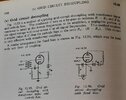What I called a Graetz bridge transformer is a transformer with half the windings of a CT transformer, requiring a Greatz bridge rectifier to function properly. I make a distinction between ”outdated technology” and ”old technology”. I use old technology all the time, where appropriate. However, there are no old technology phono amps worth considering. Mine is a D3a LCR of my own design. My line amp on the other hand uses a DHT from the 1920s, a Marconi Osram LP2. I use it in filament bias into a Lundahl 1660 line output transformer in 4.5:1 into a Tribute autoformer volume control. In my opinion this is as good as it gets. The lowest possible parts count and no super expensive resistors and capacitors in sight. The plate voltage is set with a voltage regulator tube, the English Electric globe S130P/CV45. I mostly use European voltage regulators since there is a much greater variety in voltages and currents here than what's available in America.
The power amp that I am working on at the moment is based on the Western Electric repeater amplifier (Google Lynn Olsons 2004 ETF presentation). The object is the shortest possible current loops. In fact the whole amplifier is floating above ground, except for the output transformer secondary that is grounded for safety reasons. I’m building this amp also to test the theory that the driver tube is more important than the output tube. The driver in this case is the 10y and the output the Siemens F2a triode coupled that I have used previously in other amps. The output transformer is a parafeed Tribute amorphous core. The plate choke is a nickel dressed Electra Print. The power supply of course is just as important as the signal circuit. The power transformer should have a current capacity at least three times the current draw of the amplifier. The HT filter must be choke input LCLC. Filter capacitors 4 pin DC-link in Kelvin connection, bypassed with GTO caps. It was actually Jeff Medwin who made me aware of the ”hockey puck" GTO caps. I don’t agree with Jeff very often, but I am grateful to him for this info. They sharpen up the leading edge of transients like nothing else. These days I use them everywhere in power supplies and in loudspeaker crossovers.
To make the power amp float above ground an input transformer is necessary. In fact I use input transformers in all my amps. In the phono amp the input transformer is the step up from the LOMC (LL1933ag). In line and power amps I use Lundahl LL7901, LL7903 and LL1674 as appropriate. I live 50 miles from the Lundahl transformer factory, which makes Lundahl trsnsformers an obvious choise.
With input and output transformers there is no excuse for not using balanced interconnects. I use them from tonearm output to power amp input. With balanced ICs the difference between good quality cables from different manufacturers is minimal. This makes cable swapping a thing of the past. Use a good quality, well shielded cable and you’re set for life. I use mostly Gotham cable from Switzerland, cheap but very high quality. Of course, with commercial amplifiers an XLR input or output connector doesn’t guarantee anything. It may be single ended, pseudo balanced or balanced with the well known pin one problem. The pin one problem means that the IC shield is connected straight into audio ground instead of the metal chassis close to the input connector as it should be. The result is that all the crud on the shield goes straight into the signal circuit. This is apparently a very common problem even among reputable manufacturers who should know better.
My loudspeakers also have their origin in the 1940s. They are modeled on the famous Jean Hiraga Altec VOTT A5s. I’m not quite there yet, but i’m getting close. I built them in 1988 and have upgraded and modified them over the years. Pano(maniac) of DIY Audio and Altec Users Board who helped Jean Hiraga rebuild the A5s in 1986 has stated that they are the best speakers he ever heard.

